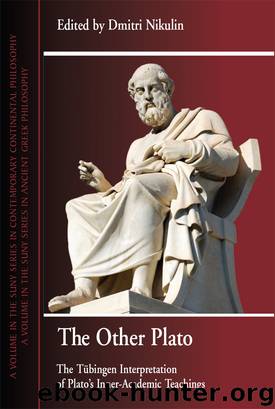The Other Plato by Unknown

Author:Unknown
Language: eng
Format: epub
ISBN: 9781438444116
Publisher: State University of New York Press
Published: 2012-11-26T16:00:00+00:00
The second main part, which I entitled “dialectic,” suggests diverse methods and insights that belong together, insofar as they are supposed to allow for an understanding of the entire divine order of being beyond the mathematical sciences. That the transcendent ideas are not mentioned in this context needs to be interpreted in a different way than in the Laws: Philippus leaves out content that would go too far for a non-philosophical audience.
The elenchic method of generalizing and bringing together (from the individual to the general), which is demanded at the beginning (991C), should already be applied within the domain of mathematics.28 The statement about useless methods of inquiry probably refers primarily to the attempt at establishing empirical certainty. Plato had already denied the value of such endeavors in the Republic, particularly for mathematics. But the method of “eidetic” summary is certainly intended to provide guidance for knowledge of the higher super-mathematical ideas and principles.
Then (991C–D) Philippus reminds the reader of the two main pillars of philosophical knowledge discussed in books X and XII of the Laws: insight into the primacy of the soul in relation to the physical domain, and into the primacy of the knowledge of the world's divine reason that becomes manifest in the exact structure of the celestial movements.
Finally (991D–992A), Philippus wants to “say at least that much” about the summary of all μαθηματικά as it is expressed in the propositions on the “one homology” and the “one bond.” Apparently, he regards this statement as “necessary” insofar as the direction and aim of the philosophical path to knowledge should be somewhat clear and distinct. Like Plato, however, he confines himself to allusions that mostly indicate the path, rather than present and describe it.
Nevertheless, the Epinomis does reveal, more clearly than the passage in book XII of the Laws and even a little more clearly than the Republic, what is meant by the synopsis of the μαθηματικά. Initially, the overview of the mathematical sciences (990C–991B) accentuates the presuppositions for the synopsis in a stronger fashion. Here as well, arithmetic, plane geometry, stereometry, music theory, and astronomy are discussed, but they are discussed in a way that stresses their connection and common ground. This is the case (I) for the connection of the μαθηματικά to one another, (II) for the opposition between unity and disunity, and (III) for the agreement of the μαθηματικά and the order of being (φύσις) as a whole.
(I) As in the Republic, here arithmetic, plane geometry, and stereometry follow one another according to the sequence of dimensions (number–line–plane–solid).29 This dimensional structure is related to the geometric proportion of numbers 1 : 2 : 4 : 8 (991A1–4). Music theory and astronomy necessarily follow these because their objects are sensibly perceivable, yet are knowable only in light of the structural laws from the preceding sciences. The entire system of the μαθηματικά is clearly characterized by the unfolding of the simple and non-spatial, to the extended in many dimensions and moving.
(II) The individual mathematical sciences are presented
Download
This site does not store any files on its server. We only index and link to content provided by other sites. Please contact the content providers to delete copyright contents if any and email us, we'll remove relevant links or contents immediately.
Kathy Andrews Collection by Kathy Andrews(10520)
Thirteen Reasons Why by Jay Asher(7788)
The Red Files by Lee Winter(2914)
How to Do Nothing by Jenny Odell(2645)
The Genius of Japanese Carpentry by Azby Brown(2609)
Stacked Decks by The Rotenberg Collection(2270)
Tattoo Art by Doralba Picerno(2083)
Champions of Illusion by Susana Martinez-Conde & Stephen Macknik(2076)
The Art of Doom by Bethesda(1774)
The Artist's Way Workbook by Cameron Julia(1725)
Calligraphy For Dummies by Jim Bennett(1643)
Creative Character Design by Bryan Tillman(1557)
Botanical Line Drawing by Peggy Dean(1529)
One Drawing A Day by Veronica Lawlor(1494)
Wall and Piece by Banksy(1459)
The Art of Creative Watercolor by Danielle Donaldson(1451)
Art Of Atari by Tim Lapetino(1325)
Happy Hand Lettering by Jen Wagner(1322)
Artificial Intelligence for Games by Ian Millington & John Funge(1302)
